

Public.asu. -- Wide Urban World blog -- Publishing Archaeology Blog -- Calixtlahuacca Archaeological Project Blog -- "Urban Organization Through the Ages" (project) I am an archaeologist specializing in the Aztecs of central Mexico.

My professional title is Professor of Anthropology in the School of Human Evolution and Social Change (formerly the Department of Anthropology) at Arizona State University. The Spanish Conquest and its Aftermath - National Institute of Culture and History. A Late Postclassic Maya chronicle, known as the “Book of Chilam Balam of Chumayel”, notes that “11 Ahau was when the mighty men arrived from the east.
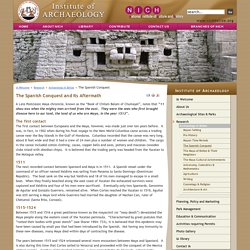
They were the ones who first brought disease here to our land, the land of us who are Maya, in the year 1513”. The first contact. History of Mexico - The Aztec Empire. THE RISE OF THE AZTEC EMPIRE By John P.
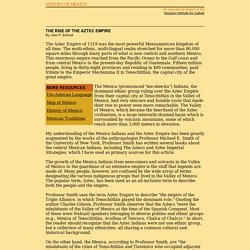
Schmal The Aztec Empire of 1519 was the most powerful Mesoamerican kingdom of all time. The multi-ethnic, multi-lingual realm stretched for more than 80,000 square miles through many parts of what is now central and southern Mexico. This enormous empire reached from the Pacific Ocean to the Gulf coast and from central Mexico to the present-day Republic of Guatemala. Fifteen million people, living in thirty-eight provinces and residing in 489 communities, paid tribute to the Emperor Moctezuma II in Tenochtitlán, the capital city of the great empire.
Houston Institute for Culture - History of Mexico. World History Timeline South America History AD 1453. Explorers of South America. James Cook (October 27, 1728- February 14, 1779) was a British explorer and astronomer who went on many expeditions to the Pacific Ocean, Antarctic, Arctic, and around the world.
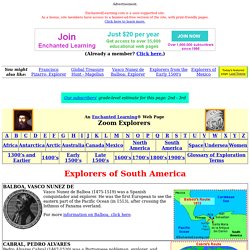
Cook's first journey was from 1768 to 1771, when he sailed to Tahiti in order to observe Venus as it passed between the Earth and the Sun (in order to try to determine the distance between the Earth and the Sun). During this expedition, he also mapped New Zealand and eastern Australia. Cook's second expedition (1772-1775) took him to Antarctica and to Easter Island. A timeline of Latin America. History of Colonial Brazil. Brazilian history can be divided in three parts: when it was a colony, then, as an empire, and years after, as a republic.
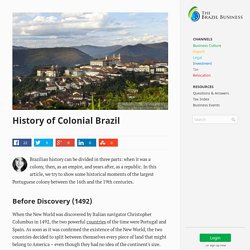
In this article, we try to show some historical moments of the largest Portuguese colony between the 16th and the 19th centuries. Before Discovery (1492) When the New World was discovered by Italian navigator Christopher Columbus in 1492, the two powerful countries of the time were Portugal and Spain. History of Mexico - Mexico. People Citizens of Mexico highly value their nation, independence and community.

Their culture is a composite of influences handed down by countless civilizations. From the early Mesoamerican civilizations to the diverse populations that live there today, Mexico’s citizens have remained proud of their heritage and their country. Many rural communities maintain strong allegiances to regions, often referred to as patrias chicas (small homelands). Spanish in America *** Spanish in AmericaSpain was one of the 'super powers' in Europe during the Age of Exploration.
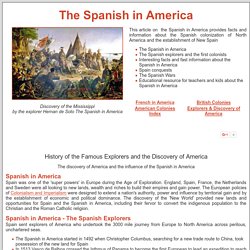
England, Spain, France, the Netherlands and Sweden were all looking to new lands, wealth and riches to build their empires and gain power. The European policies of Colonialism and Imperialism were designed to extend a nation's authority, power and influence by territorial gain and by the establishment of economic and political dominance.
The discovery of the 'New World' provided new lands and opportunities for Spain and the Spanish in America, including their fervor to convert the indigenous population to the Christian and the Roman Catholic religion. A Brief History of Piracy in the Caribbean: 1500-1730. 'First Contact: Lost Tribe of the Amazon' – Survival responds to new documentary. Still from footage of a recently contacted Sapanawa man, featured in the documentary © Channel Four/ Ronachan Films A documentary broadcast in the UK yesterday, entitled “First contact: Lost Tribe of the Amazon”, examined the situation of a group of formerly uncontacted Brazilian Indians known as the Sapanawa, who made contact in 2014.

As one of the group explained, they were fleeing from a series of massacres in which many members of their families had been killed. South America Timeline - Timeline of South America. South America Timeline: 5000 BC - 1200 BC The ancient ancestors of the people of South America were believed to have been nomadic Asian hunter-gatherers who crossed over the frozen Bering Strait and into North America.

From there they traveled south to the lands of Central and South America.900 BC – 300 BC The Chavín civilization established a trade network and developed agriculture products in the highlands of Peru.400 BC – 800 Along the central coastline of Peru, the Moche, Paracas and Nazca cultures flourished.600 BC – 1200 The Tiahuanaco and Wari empire of central and northern Peru expanded their influence to all of the Andean region.1000 BC – 1450 The Cañaris culture of Ecuador, Chimu Empire in Peru, and the Chachapoyas, and the Aymaran kingdoms of Bolivia and southern Peru flourished.1400 Machu Picchu, Lost City of the Incas was built as an estate for the Inca emperor Pachacuti.
The South American slave trade · Manchester Historian. Histories of the Trans-Atlantic Slave Trade typically focus on those enslaved in the North American colonies and often overlook its Southern counterpart.
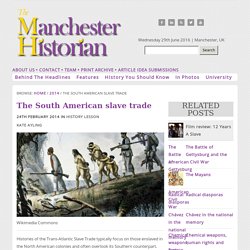
However, those enslaved in North America during the colonial period were a minority; only 6% of Africans were taken to the East Coast of North America between 1500 and 1870. Slave imports from Africa were overwhelmingly taken to South America and the Caribbean. Although the Southern United States is renowned for its past brutality towards the slave population, those enslaved in areas such as Brazil, Colombia and Bolivia experienced a much harsher reality. Yet, not unlike North America, slavery existed in South America even before African slave importation transformed the region’s landscape. After Christopher Columbus’s discovery of the Americas in 1492, much of South America was divided between the Spanish and the Portuguese with the Treaty of Tordesillas in 1494.
Affiliate School Program.